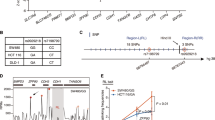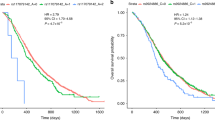Abstract
An inherited variant on chromosome 8q24, rs6983267, is significantly associated with cancer pathogenesis. We present evidence that the region harboring this variant is a transcriptional enhancer, that the alleles of rs6983267 differentially bind transcription factor 7-like 2 (TCF7L2) and that the risk region physically interacts with the MYC proto-oncogene. These data provide strong support for a biological mechanism underlying this non-protein-coding risk variant.
This is a preview of subscription content, access via your institution
Access options
Subscribe to this journal
Receive 12 print issues and online access
$209.00 per year
only $17.42 per issue
Buy this article
- Purchase on Springer Link
- Instant access to full article PDF
Prices may be subject to local taxes which are calculated during checkout


Similar content being viewed by others
Accession codes
References
Tomlinson, I. et al. Nat. Genet. 39, 984–988 (2007).
Zanke, B.W. et al. Nat. Genet. 39, 989–994 (2007).
Haiman, C.A. et al. Nat. Genet. 39, 954–956 (2007).
Yeager, M. et al. Hum. Genet. 124, 161–170 (2008).
Heintzman, N.D. et al. Nat. Genet. 39, 311–318 (2007).
Visel, A. et al. Nature 457, 854–858 (2009).
Tuupanen, S. et al. Nat. Genet. advance online publication, doi:10.1038/ng.406 (June 2009).
Bienz, M. & Clevers, H. Cell 103, 311–320 (2000).
Polakis, P. Genes Dev. 14, 1837–1851 (2000).
Barker, N., Morin, P.J. & Clevers, H. Adv. Cancer Res. 77, 1–24 (2000).
Morin, P.J. et al. Science 275, 1787–1790 (1997).
Korinek, V. et al. Science 275, 1784–1787 (1997).
Sansom, O.J. et al. Nature 446, 676–679 (2007).
Miele, A., Gheldof, N., Tabuchi, T.M., Dostie, J. & Dekker, J. Curr. Protoc. Mol. Biol. Chapter 21, Unit 21 11 (2006).
Ghoussaini, M. et al. J. Natl. Cancer Inst. 100, 962–966 (2008).
Acknowledgements
M.L.F. is a Howard Hughes Medical Institute Physician-Scientist Early Career Awardee and is a recipient of a 2006 Doris Duke Clinical Scientist Development Award. This work was supported by grants from the US National Institutes of Health (R01 CA129435 to M.L.F. and R01 CA109147 to G.A.C.), the Mayer Foundation (to M.L.F.), the H.L. Snyder Medical Foundation (to M.L.F.), the Dana-Farber/Harvard Cancer Center Prostate Cancer SPORE (National Cancer Institute Grant No. 5P50CA90381), the Prostate Cancer Foundation (to G.A.C. and to M.M.P.), the Whittier Foundation (to G.A.C.), the American Cancer Society Institutional Research Grant (IRG – 58-007-48 to L.J.) and the American Society of Clinical Oncology (to M.M.P.). We also acknowledge M.A. Brown for his support and guidance.
Author information
Authors and Affiliations
Contributions
M.M.P., N.A. and M.L.F. designed the study, analyzed all genetic and epigenetic data and wrote the manuscript. L.J., C.A.H., C.Y., B.E.H., B.F. and G.A.C. performed and analyzed ChIP and luciferase assays. M.M.P., N.A., P.H. and A.H. performed 3C experiments. M.P.V. and R.S. performed and analyzed ChIP experiments. H.D. and J.R.M. performed analysis of expression array. C.A.B. performed expression analysis of colon samples. J.A.C. analyzed colon samples and isolated nucleic acid. M.D., K.Y. and S.M.K. performed mass array assays. H.-J.L., J.Bar., A.B., J.T. and J.Bas. collected and supplied colon samples. M.M.R. contributed statistical analysis. M.L.F. conceived and directed the study.
Corresponding author
Ethics declarations
Competing interests
Dr. Manak and his group generated the expression tiling array data while he was employed at Roche NimbleGen. Dr. Manak is currently employed at the University of Iowa and has no competing financial interests with Roche NimbleGen.
Supplementary information
Supplementary Text and Figures
Supplementary Tables 1 and 2, Supplementary Figures 1–6 and Supplementary Methods (PDF 578 kb)
Rights and permissions
About this article
Cite this article
Pomerantz, M., Ahmadiyeh, N., Jia, L. et al. The 8q24 cancer risk variant rs6983267 shows long-range interaction with MYC in colorectal cancer. Nat Genet 41, 882–884 (2009). https://doi.org/10.1038/ng.403
Received:
Accepted:
Published:
Issue Date:
DOI: https://doi.org/10.1038/ng.403
This article is cited by
-
Salicylate induces AMPK and inhibits c-MYC to activate a NRF2/ARE/miR-34a/b/c cascade resulting in suppression of colorectal cancer metastasis
Cell Death & Disease (2023)
-
MYC drives aggressive prostate cancer by disrupting transcriptional pause release at androgen receptor targets
Nature Communications (2022)
-
Chromatin conformation changes in peripheral blood can detect prostate cancer and stratify disease risk groups
Journal of Translational Medicine (2021)
-
Germline RAD51B variants confer susceptibility to breast and ovarian cancers deficient in homologous recombination
npj Breast Cancer (2021)
-
Enhancer-derived long non-coding RNAs CCAT1 and CCAT2 at rs6983267 has limited predictability for early stage colorectal carcinoma metastasis
Scientific Reports (2021)



